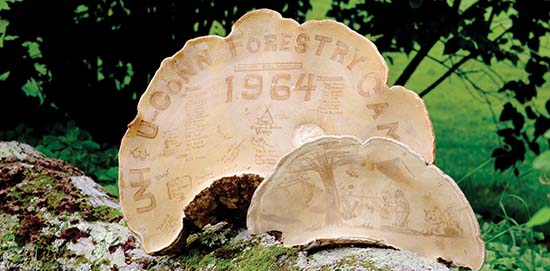 |
 |
| current issue |  | past issues |  | send a letter/news |  | address update |  | advertise |  | about us |  | alumni home |
On Ben's Farm
|
Humongous Fungus
Finding the massive mushroom was just the beginning. By Mylinda Woodward '97 |
Easy to print version |
 University Archives |
UNH forestry students were once required to spend six weeks during summer break surveying timber in Passaconaway, N.H. Like any good camp, this one, which started in 1929, had certain traditions. As the students tramped through the woods, they were always on the lookout for a type of shelf fungus found on the trunks of sugar maples or yellow birches—the cinnamon-colored Ganoderma applanatum, or "artist's conk."
"It was customary for each camp class to find a bigger conk than the previous classes and inscribe the goings on from that summer on its sensitive undersurface," recalls David Eastman '65, noting that the task had become exceedingly difficult over the years. "It would consume many hours as we cruised the slopes of Hedgehog and Potash mountains, keeping this cursed obligation in mind. No one ever thought of not accomplishing the mission, but finding and getting a 20-pound-plus bracket fungus out of the woods in good condition is demanding, to say the least."
The hardest part, Eastman explains, was removing the conk from the tree. "The white undersurface is soft to the touch, almost like human skin, and you have to avoid making impressions or scratches. A sharp instrument instantly changes the white surface to brown with the slightest contact, and after a few weeks, the image dries permanently to a saddle-leather look."
Of course, as the students searched for the elusive conk, they were also working, developing comprehensive maps of the mountainside using manila sheets and colored India ink to make notes about timber types, water sources, and other natural features. "The profs would critique [our work] later," says Eastman, "and circle errors with snide remarks like: 'Do streams run uphill??!'"
Did they find the gigantic conk before the summer was through? "You bet we did," says Eastman. "It was one of the biggest ever." The Conk of '64 is still on display in James Hall with other specimens. It was an accomplishment no subsequent class would be able to top: 1964 marked the final year for UNH's forestry camp. ~
blog comments powered by Disqus

